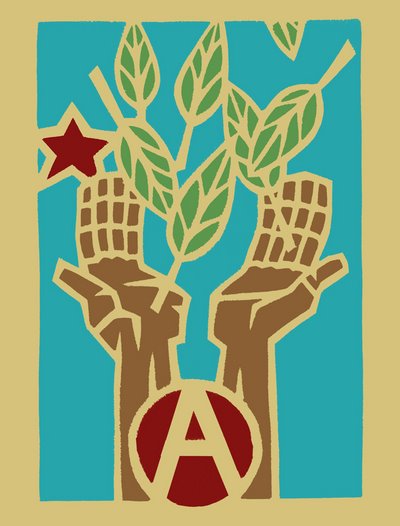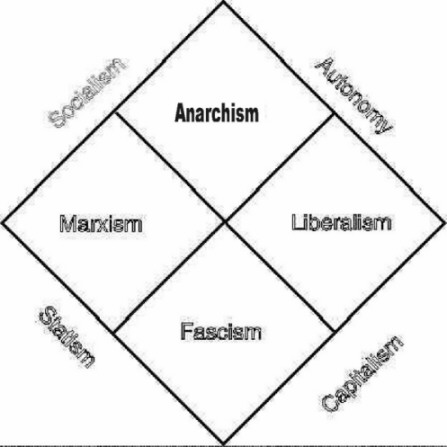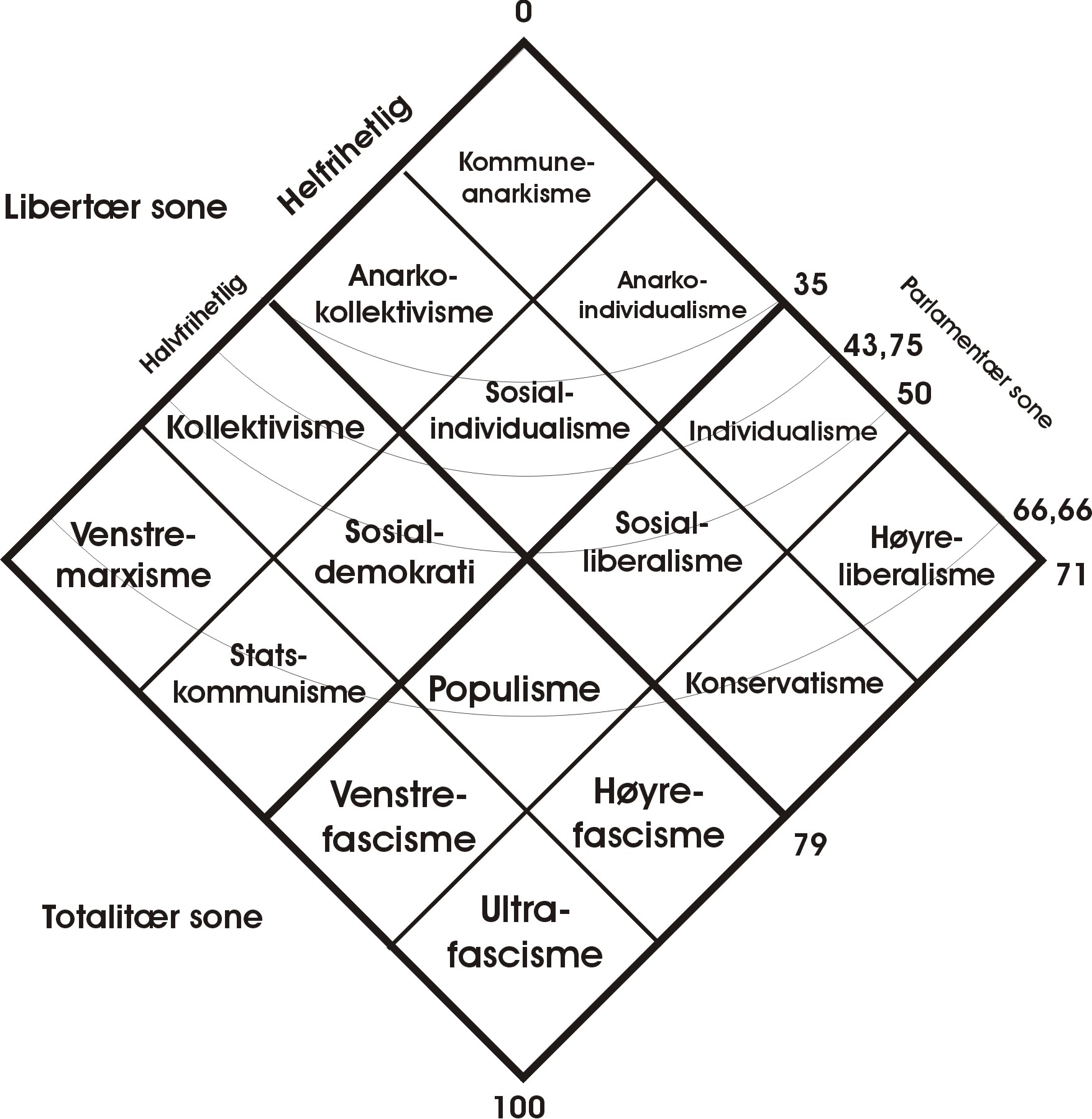
The Peoples' Journal
THE ANARCHIST INTERNATIONAL
www.anarchy.no
INTERNATIONAL
INSTITUTE FOR ORGANIZATION RESEARCH
http://www.anarchy.no/iifor.html - IIFOR P.B.
4777 Sofienberg N- 0506 Oslo - Norway
A SHORT NOTE ON ANARCHIST CONCEPTS
by IIFOR - ISSN 0800-0220
http://www.anarchy.no/concepts.html

THE ORGAN OF THE PEOPLES' GLOBAL UNIVERSITY – PGU – ADVISED BY THE OSLO SCHOOL OF ECONOMICS - OSE/INDECO.
LIBERTÆR POLITISK ØKONOMI BREDT DEFINERT - LIBERTARIAN POLITICAL ECONOMY BROADLY DEFINED.
OGSÅ AVISEN TIL DEN LIBERALE SOSIAL-DEMOKRATISKE DnA-SP-V-ALLIANSEN FOR STORTINGSVALGET 2021 OG VIDERE.
DET PROGRESSIVE POLITISKE SENTRUM - THE PROGRESSIVE MIDDLE IN POLITICS.
Translation tool Norwegian to English, French, German, Spanish, Arabic, Russian, Chinese etc., and vice versa: Google Translate.
|
 |
 |

REAL DEMOCRACY IS ANARCHISM AND ANARCHY - ANARCHISM AND ANARCHY ARE REAL DEMOCRACY
FULL DEMOCRACY = 100 % DEGREE OF DEMOCRACY = 100 % ANARCHY DEGREE = THE ANARCHIST IDEAL = THE DEMOCRATIC IDEAL
REAL (I.E. INCLUDING GREEN) DEMOCRACY = ANARCHY = ANARCHISM = LIBERTARIAN = LIBERAL SOCIAL DEMOCRACY
NORWAY, THE SWISS CONFEDERATION AND ICELAND ARE REAL DEMOCRATIC = ANARCHIES - WITH 50 % - 55 % DEMOCRACY DEGREE
THE DEGREE OF DEMOCRACY = THE LIBERTARIAN DEGREE = THE ANARCHY DEGREE WITHIN ANARCHISM
50 % DEGREE OF DEMOCRACY OR MORE BOTH ECONOMICAL & POLITICAL/ADMINISTRATIVE = SIGNIFICANT OR MORE REAL DEMOCRACY = ANARCHISM
THE DEGREE OF DEMOCRACY = 100 % - THE AUTHORITARIAN DEGREE = THE LIBERTARIAN OR ANARCHIST DEGREE
100 % DEGREE OF DEMOCRACY = 100 % LIBERTARIAN DEGREE = 100 % ANARCHY DEGREE
100 % DEGREE OF DEMOCRACY = 0 % AUTHORITARIAN DEGREE = 100 % LIBERTARIAN DEGREE = THE LIBERTARIAN IDEAL
THE DEGREE OF DEMOCRACY = LIBERTARIAN DEGREE = < 0 % - 33 % > = THE AUTHORITARIAN DEGREE = < 67 % - 100 %> =
ULTRA-AUTHORITARIAN AND TOTALITARIAN TOP - DOWN ECONOMIC-POLITICAL SYSTEMS, I.E. VERY FREQUENT WORLD WIDE!
THE PEOPLE = THE BOTTOM OF THE SOCIETAL PYRAMID VS THE BUREAUCRACY = THE TOP OF THE PYRAMID
THE DEGREE OF DEMOCRACY = THE PEOPLE'S INFLUENCE ON THE SOCIETAL DECISIONS MAINLY TAKEN BY THE TOP - IN %
REAL DEMOCRACY = A BOTTOM - UP MANAGERIAL SYSTEM = ANARCHIST AND LIBERTARIAN
NOT REAL DEMOCRACY = A TOP - DOWN MANAGERIAL SYSTEM = IN GENERAL OR PARTLY AUTHORITARIAN
REAL DEMOCRACY = ANARCHISM & ANARCHY ON THE ECONOMIC-POLITICAL MAP AND IN REALITY:

 "
"

*) The stars indicate the position of the Norwegian economical-political system after the revolutionary change in 1994/95.
Fig. 1. Picture of the Anarchist Economical-Political Map - Only the systems in the Anarchist Quadrant are real democratic.
NB! We usually have used " , ", the European standard instead of American/UK standard, i.e. " . " as decimal separator. The term "ca" is an abbreviation for the latin circa, which means about or approximately.
A SHORT NOTE ON ANARCHIST CONCEPTS
Briefly defined anarchy and anarchism mean "system and management without ruler(s), i.e. co-operation without repression, tyranny and slavery, ideally or practically". We have introduced the word practically to the definition because it may be anarchy of low degree although there are a few narcotic slaves (drug addicts) and some "wage slavery" in society, as in the Anarchy of Norway . We don't allow for regular slavery in any anarchy. More precise definitions of anarchy and anarchism vs other -isms, i.e. archies, are given by the following ten basic principles:
( 1 ) Anarchies vs archies. Societal, political-economical systems, including organizations and political tendencies; economical, political or politological, sociological and anthropological systems, may be anarchies or the negation of anarchy = archies. Thus the total amount of societal systems S = anarchy + archy <=> S = anarchies + archies. Anarchy = anarchism, with respect to societal systems broadly defined.
( 2 ) Archies may be expressed as x-archy, where x is one of a set of systems characteristics of archs, say, ( mon, olig, poly, plut, ochl, matri, patri, hier, etc; but not an) or a logical union of several x-es reflecting different forms of archy/archies as opposed to anarchy/anarchies, i.e. the negation of x-archy = archies.
( 3 ) Possibility of anarchy. It is assumed that these terms reflect concepts that may be defined in a way that anarchy is not impossible in reality, i.e. the amount of anarchies in real terms is greater than the empty set, zero. Anarchy is matter of degree = tendency. Anarchy, i.e. an anarchist social system, may have 100% or a significant degree of anarchy, i.e. less than 100%, but above a given significant level.
( 4 ) Significant anarchist tendency = anarchy. As anarchy is the negation of x-archy it may not have any amount, i.e. significant tendency towards or of, x-archy. Thus anarchy may have zero or insignificant tendency towards or of archies. The significant level is defined on aggregated dimensions.
( 5 ) Dimensions: a) There are an economic dimension and a non-economical dimension in societal, political-economical, system context: One aggregated economical, and one aggregated non-economical dimension, i.e. political/administrative rank broadly defined. Empirically this reflect economic remuneration and political/administrative rank of organizational social systems' maps broadly defined.
b) The economical dimension measures socialism vs capitalism, where the degree of capitalism is the tendency towards or of economical archies (x-archy) and the non-economical dimension is autonomy vs statism, where the degree of statism is the tendency towards or of political/administrative archies.
c) Along these two dimensions different forms of anarchy and archies (x-archy), are measured and mapped. The degree of socialism = 100% - degree of capitalism. The degree of autonomy = 100% - degree of statism. Socialism and autonomy are defined as insignificant degree of capitalism and statism respectively, and capitalism and statism is defined as significant degree of statism and capitalism respectively. Thus, socialism and autonomy are defined as significant degree of socialism and autonomy, and capitalism and statism are defined as insignificant degree of socialism and autonomy respectively .
( 6 ) Anarchism and other -isms. Anarchy is the negation of archies related to the economical and political/administrative dimensions, i.e. socialism and autonomy. Capitalism is economical plutarchy, including hierarchy and may be other x-archies broadly defined in an economical context. Statism is political/administrative monarchy, oligarchy, polyarchy, ochlarchy (mob rule), the archies of rivaling states within the state, i.e. chaos; and the tyranny of structurelessness i.e. disorganization, and/or political plutarchy, and it may also include other archies, say, being matriarchy, if the main rulers are women. Furthermore
1. Statism without (economical) plutarchy/capitalism = marxism ((state-) communism, state-socialism);
2. statism plus (economical) plutarchy/capitalism = fascism (populism included);
3. socialism without statism = anarchy = anarchism;
4. (economical) plutarchy/capitalism without statism = liberalism.
Libertarian (in the meaning of 'libertaire' (french) or 'libertær' (nordic)), and real democracy (realdemocracy) are synonyms for anarchist, anarchy and anarchism. Anarchy and anarchism are sometimes called the third alternative, social form, or way. (This must not be mixed up with Tony Blair's non-anarchist "third way = neue mitte" of Gerard Schröder, or Adolf Hitler's "dritte reich".)
Archies (x-archy) are defined equal to authority and State/government in societal context. Thus authority and State/government in societal context are liberalism, fascism and marxism broadly defined. And thus anarchy and anarchism are systems without any authority and State/government, in societal context, i.e. economical and political/administrative, also called political broadly defined.
These societal, political concepts of state/government and authority, must not be mixed up with statism and the authoritarian degree, as defined related to economical-political mapping. Furthermore insignificant tendency towards or of State/government is not State/government, and insignificant tendency towards or of authority is not authority, but anarchy and anarchism.
( 7 ) Significant level at 50%. Anarchy has less than 50% tendencies towards or of archies, x-archy, aggregated on the two relevant dimensions, on a scale from 0 => 100%. Thus more than 50 % tendencies towards or of archies, x-archy of relevant x-es, aggregated on the economic and/or the non-economic dimension, are not anarchist, not anarchy. Thus anarchy has 100-50% degree of socialism and 100-50% degree of autonomy, and archies have less of one or both, i.e. more than 50% degree of capitalism and/or statism.
( 8 ) Anarchy defined: Anarchy and anarchism mean system, coordination and management without ruling and rulers (not without rules). i.e. co-operation without repression, tyranny and slavery, and archies mean system, management and coordination with ruling and rulers, i.e. the negation of anarchy and anarchism. From greek 'an', as in anaerobe vs aerobe, i.e. keeping what is essential of the object, (in this case system, management, coordination) but without the special characteristic mentioned in the suffix, i.e. 'arch', ruling and ruler(s), from archos (ruler) and archein (ruling, being first).
( 9 ) Not totalitarian: The question of anarchism and anarchy vs archies is limited to the societal political-economical systems' management and coordination. What is interesting in anarchist perspective is whether or not the economical-political system has authority, i.e. ruling and rulers - or not, with respect to the societal managent and coordination. Other uses of the words anarchy vs x-archy and anarchies vs archies are principally irrelevant to anarchism, and should in general be avoided.
(10) Not valid concepts. Concepts as anarcho-archy = anarchy-x-archy in any form, meaning system, coordination and management "both with and without ruling and rulers" at the same time and place, are not allowed for, because such concepts are contradictive, and thus are nonsens and not logical and scientifical, because this is in reality not possible, and anarchism and anarchy are about realities. Thus anarcho-marxism, anarcho-capitalism = anarchy-plutarchy, anarcho-ochlarchy, anarcho-chaos, anarchy = chaos, anarchism = anarchy = minimal state or libertarian state, state in general, anarcho-statism, anarcho-authority, etc, are nonsense and not valid concepts, but confused Orwellian "1984" "newspeak" that is not anarchist, but authoritarian, i.e. chaotic, and should be avoided.
These axioms should be seen as fertile working hypothesis, not dogmas or absolutely truths.
Briefly defined State in a broad societal meaning is systems with significantly large rank and/or income differences and/or inefficient, i.e. significantly vertically organized. Anarchies are systems with significantly small rank and income differences, plus efficiency, i.e. significantly horizontally organized.
In addition to these axioms and most basic principles of
social sciences, anarchy and anarchism and other -isms, other
principles of policy defining authority more precise and concrete
in a societal context, structural and functional, performance
included, must be introduced, and the significant level of
anarchy vs archies must be calibrated for applied and practical
research and analysis. This is a.o.t. discussed on the file (click
on:) System theory and economic-political map , search for
'calibration' and 'principles'. The axioms (1) - (10) are
consistent with the economical-political maps below:

Authoritarian degree =
 "
"

*) The stars indicate the position of the Norwegian economical-political system after the revolutionary change in 1994/95.
The map to the right with four quadrants illustrates the four main forms of economical-political systems with a) all forms of anarchies in the upper quadrant in the middle, and b) all forms of archies in the three other quadrants. The quadrants are. 1. Marxism (State socialism), 2. Fascism (populism included), 3. Anarchism, 4. Liberalism. The map with the 16 sectors defines the four main different tendencies or subsystems of the four main forms of economical-political systems respectively. (Esquerda means left, and direita means right - the other names are easy to understand in English).
Anarchies may have insignificant tendencies of different forms of archies (x-archy), say, plutarchy, ochlarchy, etc. Plutarchy, ochlarchy, etc., in general x-archy, mentioned as parts of an anarchist system, are always insignificant tendencies of x-archies on aggregate societal level, that together make up the authoritarian tendency of the anarchist system, measured by the authoritarian degree (the distance from the top of the map). Ochlarchy broadly defined as an authoritarian tendency is further explained in the (click on:) Oslo Convention. Thus, there may to a minor extent be small, or local, plutarchs, ochlarchs, etc., in general x-archs, in an anarchist system, especially at relatively low degrees of anarchy, as long as they all in all don't represent a significant authoritarian tendency on aggregate, societal level.
Such small, or local, plutarchs, ochlarchs, etc., in general x-archs, are usually called plutarchists, ochlarchists, etc., in general x-archists, to get a more logical use of the words. Thus, real plutarchs, ochlarchs, etc. in general x-archs, are significant plutarchs, ochlarchs, etc. in general x-archs, on societal level. They must all in all make the degree of statism or capitalism or both > 50%. Significant tendencies of plutarchy, ochlarchy, etc., in general x-archy, on aggregate societal level, in economical as well as political/administrative terms, may not exist in an anarchist system. If significant tendencies of plutarchy, ochlarchy, etc., in general x-archy, on aggregate societal level, either in economical or political/administrative terms, exist in a system, the system is a form of archy - and not anarchy.
All capitalist (degree of capitalism > 50%) systems (fascist and liberalist) are economical plutarchies, i.e. have a significant economical plutarchist tendency on aggregate societal level. Economical plutarchies may in general also be mixed with other significant x-archies defined in economic terms, say oligarchy. Fascist systems always have both a significant economical plutarchist tendency, and statism (significant degree of statism, i.e. > 50%). The statism (significant) is defined by x-archies in political/administrative terms, i.e. significant tendency on aggregate, societal level.
Marxism, i.e. state-socialist systems, may not have any significant capitalist/economical-plutarchist tendency on aggregate, societal level, but of course have statism (significant). Plutarchy defined in political/administrative terms is always connected to economical plutarchy, but economical plutarchy may of course be without political/administrative plutarchy. Liberalist systems may not have any statism (significant degree of statism > 50%) on aggregate, societal level. Thus systems within the liberalist quadrant have a degree of autonomy > 50%, they have autonomy (significant). The borders of the anarchist quadrant represent anarchist systems. The border between the marxist and fascist quadrant represents marxist systems and the border between the fascist and liberalist quadrant represents liberalist systems.
Anarchism and anarchy are socialism plus autonomy as defined above, see the economic-political map, a system significantly flat organized both economic and political/administrative, efficient and fair, without top heavy pyramid economically and/or political/administrative, based on significant statism and/or capitalism. The results of the economic-political systems of the anarchies Norway, the Swiss Confederation and Iceland confirm the basic libertarian hypothesis that a horizontal structure, i.e. a significant autonomous and socialist system, is efficient and fair. Empirical data of other systems confirm that a top heavy structure, capitalist (economical plutarchist) and/or statist, is unfair and/or inefficient.